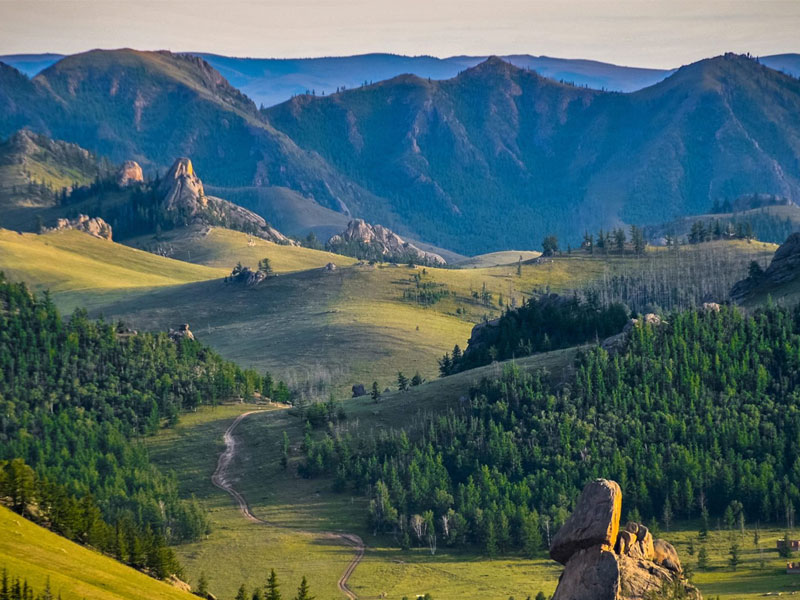
ABOUT MONGOLIA
Introduction
Mongolia is one of the elevated countries in the world with one of Eurasia's highest capitals. Average altitude: 1,580m above sea level. The capital city Ulaanbaatar: 1,380m above sea level. The highest point is the “Tavan Bogd” mountain (4,374m) in the west and the lowest is the “Khokh Nuur” lake depression in the east - 554m above sea-level.
The country's geography is characterized by a great diversity. Mongolia is divided into six basic natural zones, differing in climate, landscape, soil, flora and fauna. Due to its over 200 sunny days a year, Mongolia is known as the "Land of the Eternal Blue Sky" or "Country of Blue Sky".
|
Capital |
Ulaanbaatar |
|
Population |
3.29 million (2019, NSO) Largest ethnic groups: Khalkha – 82,4%, Kazakh – 3,86%, Durvud – 2,75%, Bayad – 2,15%, Buryat – 1,71%, Zakhchin – 1,25%, Dariganga – 1%, Uriankhai – 1%, other smaller groups are less than 1% respectively. |
|
Religion |
Religious people – 61,4% (Buddhism – 86%, Muslim – 4,9%, Shaman – 4,7%, Christian 3,5%, others – 0.5%), Non-religious – 38,6%. |
|
Area (in sq. km) |
1,564,120. Mongolia is ranked in the 19th in the list of the countries by total area. |
|
Language |
Mongolian |
|
Boundaries |
Mongolia is bordered with Russian Federation (2,166 miles-3,485 km) to the North, with China (2,906 miles 4,677 km) to the East, South and West. |
|
Economy |
Capital Ulaanbaatar is the hub of most domestic and international trade and relations. Mongolia's economy is centered on agriculture and mining. Mongolia has rich mineral resources, and copper, coal, molybdenum, tin, and gold account for a large part of industrial production. The majority of the population outside urban areas participates in subsistence herding; livestock typically consists of sheep, goats, cattle, horses, and camels. Agricultural crops include wheat, barley, potato, vegetables, and tomato, watermelon, sea-buckthorn and fodder crops. GDP growth in 2019 was 5.1%. Export structure: Commodities – 83.7%, precious metal stones – 5.5%, textile – 5,7%, amimals and animal by-products 1.28% Main export partners: China, Russia, Canada, UK, Russia Major imports: Machinery and equipment, fuel comprise, also, cars, food products, industrial customer goods, chemicals, building materials. Main import partners: China, Russia, US, Japan, South Korea, Germany Mongolia receives about 400.000 foreign visitors annually. |
|
Type of Governance |
Parliamentary republic Legislative branch: State Great Hural (Parliament), unicameral, 76 seats; members elected by popular vote to serve for a term of four years Executive branch: Prime Minister and Cabinet, appointed by the Parliament Judicial branch (independent): Supreme Court, the highest court for the provincial courts but rarely overturns verdicts of lower courts; judges are nominated by the General Council of Courts for approval by the President. Head of State: President (symbolic), elected by popular vote to serve for a four-year term and can re-elected for the next term. |
|
Foreign Policy |
Mongolia pursues open, non-aligned, multi-pillar foreign policy. It develops friendly relations with all countries and encouraged pursuing active “third neighbor” policy. |
|
Defense |
The Mongolian Armed Forces is tasked with protecting the independence, sovereignty, and territorial integrity of Mongolia. Defined as the peacetime configuration, its current structure consists of three branches: general purpose forces, border defense forces, and internal security forces. Mongolian armed forces have been performing peacekeeping missions in South Sudan, Chad, Iraq, Afghanistan, and in Sierra Leone under the mandate of the United Nations Mission in Liberia. Recently, Mongolia deployed 900 troops to South Sudan and 240 troops to Afghanistan. |
